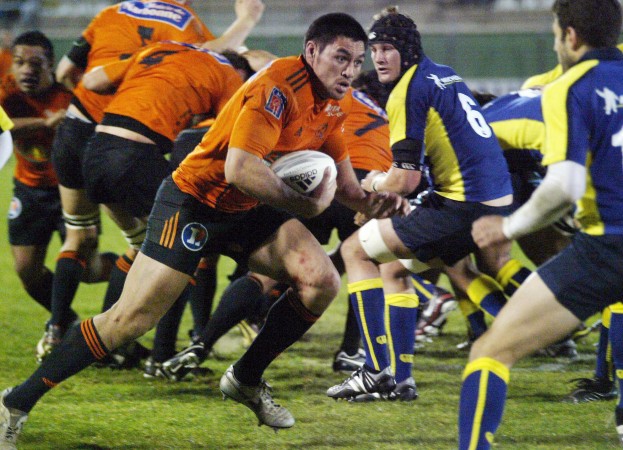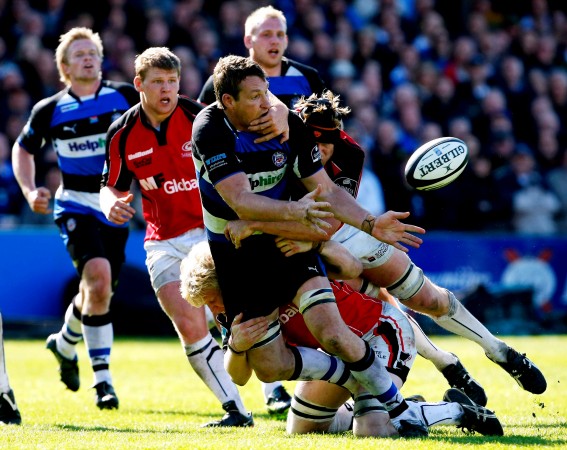Proud ProD2 outfit Narbonne are battling hard to avoid the drop despite an ambitious Australian overhaul that saved the French club. By John Davidson
The Parc des Sports Et de L’Amitie stadium was rocking, flares were going off and the fans celebrated with gusto. Racing Club de Narbonne Mediterannee, better known as RC Narbonne, had just pulled off a famous ten-point derby win over arch-rivals Perpignan. Saturday’s victory, inspired by a two-try haul from former All Black Jerry Collins, had given Narbonne a tiny amount of breathing space in its relegation dogfight. With just four matches in France’s ProD2 season left, the Orange and Blacks sit in 14th place on 41 points, the same number as 13th ranked US Dax and one point above Bourgoin in 15th place.
Of the three clubs, Narbonne has the easiest run in and crucially faces both Bourgoin and US Dax on its home turf. It is in the box seat to survive and there’s no denying that relegation would be a bitter blow after the heights of the 2013-2014 campaign. In the previous season Narbonne had finished fifth, with 18 wins from its 30 matches, and had almost gone up to the Top 14. The small club from Languedoc-Roussilon had gone down to Agen 25-17 in the semi-finals, but had performed admirably.
In comparison, 2014-2015 has tough. Narbonne lost its scrum-half, ex-Wallaby Josh Valentine, to a big-money move to Beziers while a number of other key players departed. The club has been plagued by injuries and for the past few weeks the likes of half-back Brett Sheehan and forward Lei Tomiki have been sidelined. But the January arrival of New Zealand great Collins from the wilderness, as the medical joker replacement for former Australia skipper Rocky Elsom, has helped spark a turnaround.
Narbonne have won three of their past five matches and will be boosted by the return of Tomiki and Sheehan before the end of the season. “Last season no one expected anything and we did really well,” Tomiki says. “And this year, it was probably the same thing but I think everyone’s kind of caught on to it. We’re a bit of a target. The main focus is to stay up. I think the boys are up for it.”
Remaining in ProD2 is vital for a club as ambitious as Narbonne and for one that has experienced a huge amount of change in the past few years. Relegated from the Top 14 in 2008, it almost went under three years ago. Bought by an Australian consortium and now majority-owned by Elsom, Narbonne’s finances have been brought back into control. Employing their own version of a rugby ‘Moneyball’ strategy, Elsom and fellow Australians in club president Anthony Hill and coach Justin Harrison have cut costs and initiated a restructure. Using their southern hemisphere contacts they have brought in a load of antipodean cattle, a mixture of seasoned Super Rugby professionals and younger players, and paired them with local French talent.
Unable to compete with the big bucks thrown around by the larger club, Narbonne have raised performance standards and increased its reliance on state of the art sports science programs to close the gap. The club’s model is to spot talent early and develop it, selling it on to rival outfits when necessary, while at the same time increasing its sponsorship base and financial strength. New sponsors have been enticed, crowds have gone up and Narbonne’s engagement with the local community has increased. “That’s one thing I found about coming to Narbonne, the whole culture of the place and the community gets behind their team,” Sheenan says. “It’s their passion… obviously we haven’t had the best success on the field this year but they still rock up. They celebrate with you and they bleed with you. It’s a great environment to be in.”
French rugby is changing rapidly and Narbonne want to be part of that bright future. The Top 14 may be swimming with cash but the step up to that top level is not easy. Narbonne’s mixture of sound spending, canny recruitment and innovation is different to the ProD2’s status quo, but could pay off in the long run. “You want to tilt the probability dramatically in your favour to be able to win,” Elsom explains. “It’s one thing that good teams do all the time. So New Zealand certainly have excellent players, but they also have things stacked in their favour because they’ve made it that way. Things like the performance program, the talent and development programs, so the young guys coming through. And also better utilising the resources in the town, connecting with other sports and having a stronger link with the average punter.”
In the May issue of Rugby World – in shops now – we talk to some of the former Test stars and career pros plying their trade in ProD2. Find out where to buy your copy here or download the digital edition here.







